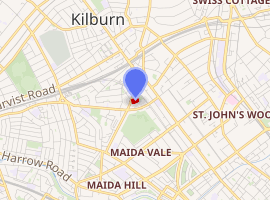St Augustine's, Kilburn
Saint Augustine's, Kilburn, is a Church of England church in the area of Kilburn,[1] in North London, United Kingdom. Because of its large size and ornate architecture, it is sometimes affectionately referred to as "the Cathedral of North London",[2] although the church is not a cathedral in any official sense.
| St Augustine's, Kilburn | |
|---|---|
 | |

| |
| Location | City of Westminster, London |
| Country | United Kingdom |
| Denomination | Church of England |
| Churchmanship | Anglo-Catholic |
| History | |
| Founder(s) | Richard Carr Kilpatrick |
| Dedicated | 1880 |
| Architecture | |
| Architect(s) | John Loughborough Pearson |
| Years built | 1871–1897 |
| Administration | |
| Diocese | London |
| Clergy | |
| Bishop(s) | Bishop of Fulham |
| Vicar(s) | Colin J. Amos |
| Archdeacon | Archdeacon of Charing Cross |
History
St Augustine's was founded by Richard Carr Kirkpatrick in the Anglo-Catholic tradition in 1870. By 1871, a foundation stone had been laid and the original "iron church" was subsequently replaced by a much more ambitious building, a Gothic Revival church designed by John Loughborough Pearson. It is listed as a Grade I building by Historic England.[3]
Architecture
Pearson's plans called for a red brick structure, vaulted ceilings, and extensive interior stone sculpture in a style reminiscent of 13th-century Gothic architecture. The church was consecrated in 1880, but the tower and spire, remarkable for such structures in the Victorian era, were not constructed until 1897–1898.[4] Sir Giles Gilbert Scott designed the reredos (altar screens) for the high altar in 1930. He also designed the reredos of the Lady Chapel and the Stations of the Cross. In 1878, two years prior to the dedication of the church, contemporary historian Edward Walford had already referred to St Augustine's, Kilburn, as "one of the finest examples of ecclesiastical structures in London".[5]
The spire measures more than 77 metres (253 feet) high. Completed in 1878, the nave measures nine metres (28 feet) wide with nine bays and a crossing that is bounded by transepts on the north and south sides. The religious art in various forms depicts most of the major biblical stories. Clayton and Bell created the stained glass windows, which include a large rose window depicting the Creation, nine clerestory windows (five depicting types of angels), nave windows depicting saints connected with England, a window depicting Saint Augustine and several other tall lancet windows. Paintings around the nave depict the healing ministry of Christ. The chancel and sanctuary are surrounded by densely-carved sculptural forms representing the Passion, Crucifixion, Entombment, and Resurrection of Christ, as well as the Apostles, saints and other religious iconography. The south transept leads to St Michael's Chapel with depictions of the Eucharist, sacrifice, angels and the worship of Heaven. The Lady Chapel presents frescoes of the Christ child and a later carving of Christ's Presentation in the Temple.[6]
 The nave (looking east)
The nave (looking east) The rood screen
The rood screen The nave (looking west)
The nave (looking west) The sanctuary
The sanctuary
Today
The church stands prominently to the south of Kilburn and the north of Maida Vale. It has two schools, St Augustine's Primary School and St Augustine's High School.
Congregational history
Richard Carr Kirkpatrick served as parish priest at Saint Augustine, Kilburn, from 1870 to 1907. He formed the church after his parish at St Mary's, Kilburn, where he served as curate, received an evangelical vicar unsympathetic to the Anglo-Catholic movement (also referred to as the Oxford Movement, "Tractarians" or disparagingly as "Puseyites" after one of the founders of the movement, Edward Bouverie Pusey). Kirkpatrick was followed in the vicarage by:
- Philip Leary, 1907–1930
- William Percy Theodore Atkinson, 1930–1954
- Harold Riley, 1955–1975
- Claude Eric Hampson, 1975–1977
- Raymond John Avent, 1977–1987
- Paul Tudor Rivers, 1987–1994
- Anthony H. Yates, 1995–2011
- Colin J. Amos, 2012–present
In popular culture
The interior of St Augustine's Church was used in the filming of Young Sherlock Holmes (1985), for the church of the Reverend Duncan Nesbitt (played by Donald Eccles). In the scene, Nesbitt is hit by a poison dart, and begins hallucinating about one of the stained glass figures (a knight) coming alive and trying to kill him. This knight is noted for being the first fully photorealistic CGI-animated character in any feature film.[7][8]
Gallery
 West rose window
West rose window Western arcade
Western arcade The font
The font Pulpit
Pulpit Statues on the Rood Screen
Statues on the Rood Screen The Rood flanked by Saints Mary and John
The Rood flanked by Saints Mary and John Painting north-west, Christ among the Doctors
Painting north-west, Christ among the Doctors The sanctuary pavement
The sanctuary pavement Throne in the sanctuary
Throne in the sanctuary Chapel of St Michael
Chapel of St Michael Altar in the Lady Chapel
Altar in the Lady Chapel
References
- Although in the Kilburn area, the church is located just within the boundaries of the City of Westminster – see map for exact location
- https://www.staugustinekilburn.org/history. Accessed 17 May 2020.
- "A Church Near You" website, Church of England, accessed 2 March 2008, http://www.acny.org.uk/venue.php?V=15756%5B%5D.
- Humphrey, Stephen and James Morris, Churches and Cathedrals of London, New Holland Publishers (London), 2006.
- Edward Walford, Old and New London: Volume 5, British History website, accessed 2 March 2008, http://www.british-history.ac.uk/report.aspx?compid=45234
- Saint Augustine, Kilburn website, accessed 2 March. 2008, http://www.saint-augustine.org.uk/section/14 Archived 23 July 2008 at the Wayback Machine.
- "Visual and Special Effects Film Milestones". www.filmsite.org. Retrieved 19 February 2019.
- "Section 14: CGI in the movies". web.archive.org. 26 January 2014. Retrieved 19 February 2019.
External links

- Official parish website